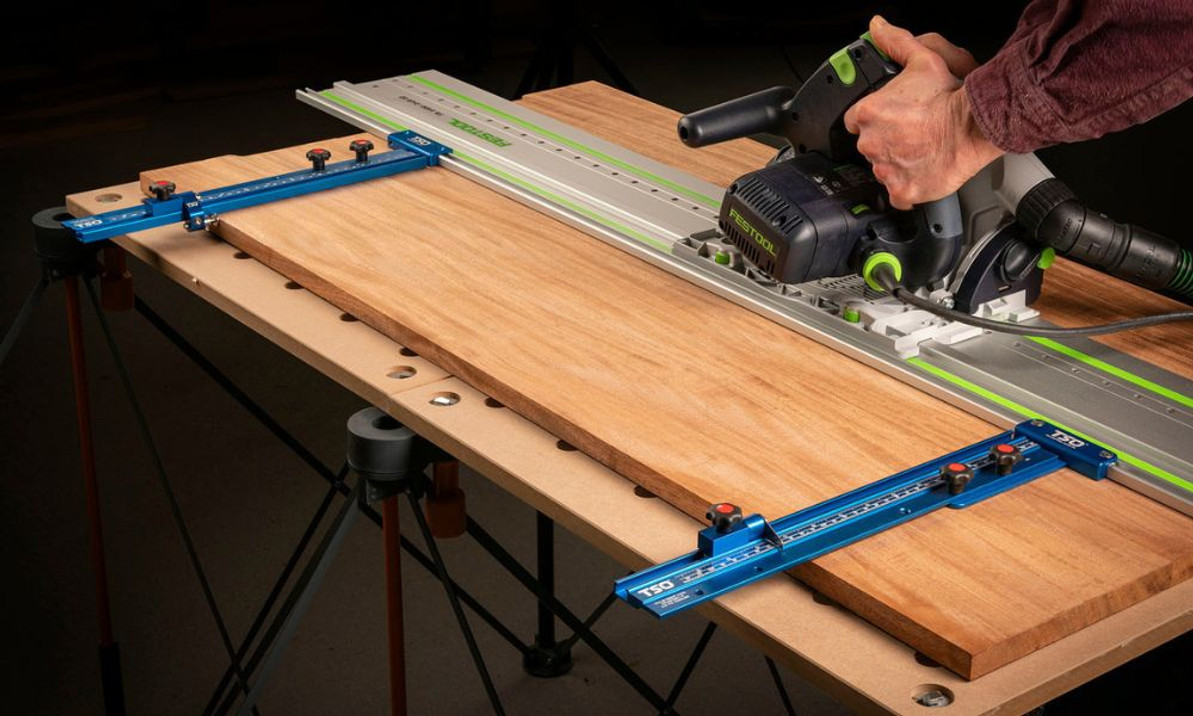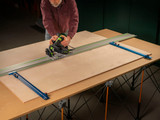Building Cabinets With a Track Saw and Parallel Guide System
Can you build an entire kitchen cabinet set with nothing more than a track saw parallel guide? Yes, you can. In fact, these precision tools and accessories empower woodworkers to create high-quality cabinets accurately and efficiently.
The key to successfully building cabinets with a track saw and parallel guide system lies in the combination of skill, meticulous planning, and the right tools. Let’s explore how these tools and others make this ambitious project achievable.
1. Track Saw
Designed for making precise straight-line cuts at 90-degree angles or at a bevel angle, the track saw excels at cutting large sheets like hardwood veneered plywood and MDF commonly used in cabinet construction. You can cut all the cabinet components, including panels, doors, and shelves, to the desired size and shape with careful measurements and an accurate setup. The track saw’s clean and splinter-free cuts are ready to accept veneer edge tape, giving your cabinets a nicely finished appearance.
2. TSO Parallel Guide System
The TSO Parallel Guide System is an invaluable accessory for cabinet making. It allows you to set consistent and repeatable measurements for making parallel rip cuts and crosscuts, ideal for creating cabinet sides, shelves, and dividers. This system is ideal for batching a series of cabinet components sharing the same cut dimensions, reducing variability and the risk of errors and rework.
3. GRS-16 Guide Rail Square
The GRS-16 Guide Rail Square also enhances the precision of your track saw cuts. It ensures your cuts are perfectly perpendicular to the edge of your workpiece, which is essential for the assembly of square cabinets. With this guide rail square, you can quickly and confidently create panels to the precise dimensions of your project.
What Else Do I Need To Consider?
While these three tools are incredibly useful for the initial stages of cabinet construction, they do have limitations when finishing your work. They won’t, for example, route fine edge details into your cabinet door rails and stiles. Here are a few areas where you should consider supplementing your tool arsenal:
1. Detailed Joinery
The track saw lacks the precision required for intricate joinery like creating the mortise and tenon joints common in cabinet doors. For such tasks, routers with specialized bits are the bee’s knees!
2. Edge Profiles
Achieving decorative edge profiles or beading, often seen on cabinet door frames, demands the finesse of a router table or handheld router. These tools allow woodworkers to add intricate designs and profiles that enhance the aesthetics of cabinet components.
3. Hardware Installation
Mounting hinges, knobs, and handles on cabinet doors and drawers necessitates accurate measurements and precise hole drilling. While the track saw and guide systems are excellent for dimensioning, drill drivers and dedicated drilling jigs and templates are necessary for exact hardware placement.
4. Finishing Touches
The final steps of cabinet construction—sanding, applying finishes, and ensuring flawless surfaces—rely on hand tools like sandpaper, scrapers, and brushes. These tools allow woodworkers to achieve a level of detail and finesse that power tools alone cannot provide.
It’s amazing how far you can get in building cabinets with a track saw and parallel guide system. Supplementing a router, arguably the most versatile woodworking tool around, is a decision you’ll likely not regret.
Recent Posts
-
What Size Guide Rail Do I Need? Choosing the Right Length (and When to Use Extensions)
The scenario: you need to make a cut in that full size plywood panel sitting in the corner of your s …6th Nov 2025 -
Best Track Saw Systems: Expert Review & Advice
The track saw market has changed considerably over the past three years. Back then, your options wer …6th Nov 2025 -
Systainer Storage Guide: Organize Your Workshop Tools
Picture this: you're setting up for what should be a straightforward series of cuts, but you can't l …2nd Sep 2025




